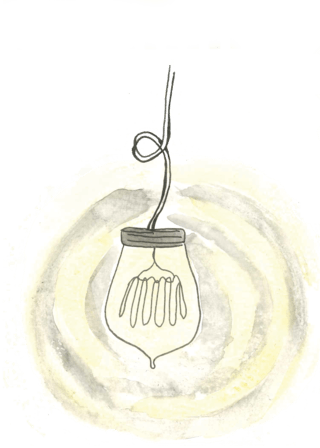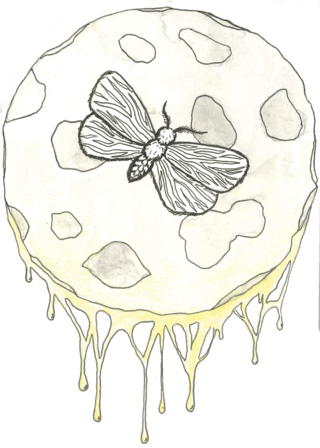Actias Luna
“Thus hath the candle singd the moath.” The Merchant of Venice, by William Shakespeare
Aside from a few exceptions, butterflies tend to be much more brightly colored than moths. Moths also have plumper bodies, and their antennae are clubbed.
The moths genuinely do not mind that they carry a few more milligrams, for their diets contain an extra food group butterflies’ antennae cannot absorb. Additionally, moths — despite what the butterflies think — are not jealous of their cousins’ appearances. The majority of moths find the butterflies’ brightly-colored wings unnecessarily loud (though far more flattering when compared to their own softer, more neutral tones). Whenever they hear that sentiment, the butterflies just roll their compound eyes and flit to the nearest flower.
Though they are both in the Lepidoptera order, butterflies and moths do not get along with one another.
Butterflies, if you can’t already tell, have a tendency to focus quite narrowly on physical beauty. That does not mean butterflies are any vainer than moths (moths think quite highly of themselves, as well), but they take excessive pride in their appearance and are known to lord that over their cousins. For this reason,
Moths are nocturnal.
They move about when the butterflies are asleep and we humans stare at the stars or screens or the backs of our eyelids. They don’t need the world to look at them, for they do not often want to be seen. It’s not that they’re any more afraid of us than butterflies (though their colorful counterparts often claim that’s the case); they just don’t feel the need to be the center of attention. When we do see moths, it’s often because they’re far more focused on something else. Something far more important than us.
Moths drink the light from our lamps and flames.
Thomas Edison’s final working lightbulb (and all the other ones that came after it) has in fact failed, for he forgot to protect the light from the moths. When the world turns its face from that great and powerful sun, the moths emerge to feed. Flower nectar provides vital nutrients, but once the moths have eaten the daily moth equivalent of brussel sprouts and kale, they fly towards the nearest light source. The taste of light — either in an organic flame or the pre-packaged electric variety — is widely accepted by moth culture to be the single greatest thing in the universe. Slightly warm and butter smooth, the closest comparison to the taste of light in the human world is something like a combination of a strawberry milkshake and melted caramel, with a spicy undertone not unlike chili peppers (the taste is earthier with a natural flame and sharper with an electric light). It is not so much of a drug as a dose of confidence.
If we have learned anything from moths, it is not to drink too dangerously.
The moon’s light is cooler than that of the sun.
Moth culture respects and fears the sun (for it is simultaneously the largest source of light and the most dangerous). But it appreciates the moon in a much more personal way. That soft white light graces the tips of their dully-colored wings and reminds them that the universe is kinder than it seems.
Many believe that moths use the moon as a guide for navigation.
In fact, the closest human translation to the moth word for moon is “Mother Who Watches and Smiles.” Moths do not have close relationships with their parents, so they look up to the moon whenever they are spiritually or physically lost. They do not claim to hear anything from the moon — that would be ridiculous — but its kind, gentle light often nudges them in the right direction. This explains why the vast majority of moths move only at night, for the moon’s benevolent gaze gives them enough confidence to explore the darkness.

Many adult moths do not eat. The adult luna moth, for example, has no mouth and lives only for a week.
Moths do not drink light through their mouths. Their antennae — which often appear feathery — drift across the light source and absorb its nectar. The luna moth subsists only on the wisps of light it sweeps from the flames and buzzing neon signs (which add a sour tinge that makes the moth’s wings tingle). When its week is up, it gives itself to the moon. The moon in turn accepts the sacrifice and sends down reed-thin rays of soft light for the moths.
Butterflies have a different concept of death.
They don’t explain it very well, but we’ve gathered that it has something to do with stained glass.
When we find a moth or butterfly and touch its wings, the powder that comes off onto our fingers is actually miniscule scales.
It is generally assumed that their duller coloring evolved to catch the malleable moonlight. Butterflies, on the other hand, have much brighter colors and cannot absorb moonlight the way their cousins can. They must move about in daytime, absorbing the more metallic-tasting sunlight. This arrangement suits both parties well: butterflies can bask in our appreciative gazes while the moths wait for the moon and porch lights to appear.
If we have learned anything from butterflies, it is that confidence in one’s beauty is just as important as the beauty itself.
When moth caterpillars construct their cocoons, they use bits of wood or leaves and then make silk to bind it all together.
Butterflies don’t bother with silk. It doesn’t coordinate well with their color palette. They prefer instead to build a much harder cocoon that looks like a leaf, for it fits more naturally into the aesthetics of the tree. Moths prefer to cling to the sides of the tree instead of hanging from them: they are more cautious than their colorful counterparts. Additionally, they find great significance in the silk-making process (which is quite painstaking) because
Moth silk is in fact the solidified essence of its weaver’s life story.
The language they use is too quiet and kind for the human world to perceive, so we see it in solid form: delicate, silvery strength translated into threads for holding things together.
The silkworm (a moth caterpillar) is domesticated for its production of silk.
We don’t quite know what each strand of silk says, but we subconsciously understand that it is beautiful and powerful in an almost-invisible sort of way. That nearly indescribable feeling of silk sliding over skin is precisely the sensation moths feel when the moon sends down its reed-thin rays of light.
Both butterflies and moths remember when they were caterpillars.
Butterflies just prefer to forget that time. They equate their caterpillar phase with our own middle school years — awkward, ungainly, and involving far more eating than necessary. Moths, on the other hand, find great significance in their pre-winged lives. They cocoon themselves in the memories of those formative few weeks and ruminate on the lives they’ve lived so far. And when they’ve learned all they can from the first part of their lives, they move on to the second. But despite all that introspection,
Moths are not always prepared for the danger of flames.
They don’t understand them; as caterpillars, they merely hear of the gustatory bliss they would eventually experience when their antennae had evolved the ability to drink light. Moths are aware that there is some sort of link between the sun and fire, but their knowledge in that field of science is incredibly limited. Without the guidance of their parents, moths generally live their adult lives through trial and error. After a dangerously close run-in with flames and some marginally singed antennae, most moths learn their lesson and live the rest of their lives with more caution.

Light-sickness has always existed in moth history, but its prevalence has increased dramatically with the invention of electric light. If a moth spends too much time in close proximity to light, it will go temporarily blind.
Aside from the physical reaction (in which a moth’s eyes are slow to readapt to the darkness, hence a clouding of vision), moths experience an additional side effect when they drink an excessive amount of light. It is not drunkenness, per se. This light-sickness is much closer to those moments when you are reading a story so compelling that you forget the world around you exists. When moth’s antennae absorb this light, it fills them with such hope and confidence that the very scales on their wings vibrate. In those moments, the moths completely forget about their chubby weeks as caterpillars and the scoffs of the butterflies. When a moth drinks the light of a lamp or a flame, it feels the pride of the moon and the stars deep in its abdomen. If it continues drinking, the moth feels as though it could take on the sun.
This is very dangerous.
Once this idea pollinates a moth’s mind, it does not leave. Moth society whispers of these moths in the hushed hours of mid-afternoon, when the saner members of the species are either sleeping or searching for a daytime snack. Light-sick moths do not give up on their search for light during the day. Though their wings prickle painfully when excessive sunlight begins to stick needles in their scales, they continue onward, flying in staggering loops and whirls until the sun goes down and the electric lights click on. (Campfires and other sources of natural flame are much harder to find nowadays.)
There are two kinds of blindness: the physical inability to see and the conscious refusal to look.
Moths are particularly attracted to ultraviolet light.
We are not quite sure why the attraction is so strong, but the few light-sick moths we’ve interviewed say that it makes them feel as though they themselves are glowing. Most moths are wary of this light, for something about the thick buzz that emits from ultraviolet light sources feels dangerous. It smells like a crueler version of the sun, which moth culture deeply fears. Light-sick moths, on the other hand, are so blinded by the warmth bubbling through their bodies that they no longer feel that trepidation. For this reason,
No moth has ever recovered from light-sickness.
Their blindness so consumes them that they forget the silken stories they wove into their cocoons. The moon no longer watches and smiles, but weeps star-like droplets with every moth that flies straight into the flames of a fire without recognizing the sting of a light which wants to consume it. Or they are pulled in by the intoxicating buzz of the ultraviolet bug zappers some of us set out on summer evenings.

Moths’ life spans are quite short: After emerging from their cocoons, they may only live for a few days or weeks.
It is a miracle in itself that moth culture exists at all. That there is a collection of myths, proverbs, histories, and legends which is passed down from one flight of moths to the next. Life moves infinitely faster after they emerge from their cocoons with the entire sky now open to them, so their concept of time is not measured in seconds and hours but wingbeats and wind changes. Even then, there is barely enough time to educate the next flight of moths before one must give itself to the moon.
But some don’t hear the myth of Icarus, and they drink too deeply.
